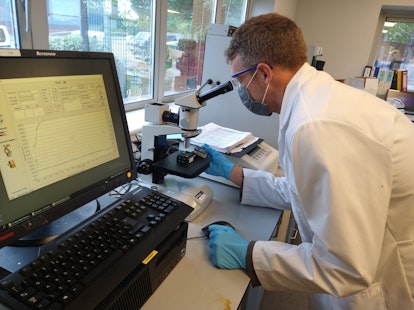Microbes living in oil and gas fields can lead to the plugging of systems, the production of toxic gases and corrosion, and have a significant impact on costs.
More than 30% of corrosion-related costs in the oil and gas industry are caused by microbial communities. These problems also have a negative effect on health and safety, and on the environment, which can cause legal issues and damage a company’s reputation.
Through the use of DNA sequencing technology and our proprietary microbial risk assessment (MiRAS) database, SGS can identify and monitor microbes, determine the risks they pose to assets, and provide advice on how to mitigate them.
How microbes thrive
To produce oil and gas and build infrastructure to transport it, the ideal conditions for microbes to thrive were inadvertently created. As a result, microbes do what they have evolved to do for almost two billion years: grow, multiply and extract energy from the metals around them. By doing so, they cause rapid, severe and often very localized corrosion.
Microbial ecosystems
Although there are microbial species that can attack steel alloys in solitude, the most aggressive corrosion is often observed when a diverse set of species are present. In these ‘ecosystems’, microbe species survive and thrive synergistically with each other, which consequently can enhance corrosion.
While historically the industry has largely focused on a single species or a particular functional group of microbes when monitoring their facilities, SGS now looks at the entire ecosystem. Using this ‘ecosystem approach’ is key to the successful assessment of the ‘microbial risk’ for oil and gas fields and their facilities. At SGS, we use advanced and innovative DNA technology to accurately identify and validate all species present in a sample to facilitate this approach.
DNA technology
SGS uses Next Generation Sequencing (NGS) DNA technology to screen and monitor microbial communities in oilfield samples and detect all microbial species or taxonomic groups in virtually any sample type. After NGS analysis has identified all species in a sample, SGS utilizes a proprietary Microbial Risk Assessment (MiRAS) Database to link species traits and assemblages to corrosion, biofouling or souring risk.
This database is populated with information on metabolic pathways, corrosion tendency and environmental parameters (e.g. temperature, pH, salinity, oxygen tolerance, etc.) for all microbial species.
On the basis of system temperature and fluid chemistry, we can then identify which species could not survive at the corrosion site. This helps us to filter out ‘contaminations’ originating further upstream or species introduced during sampling. The result is a robust corrosion or souring risk assessment for specific areas of a subsurface reservoir or facility.
In addition, the use of NGS alleviates issues with shipping live samples and there is no longer a need to wait for results of culture tests. When possible, SGS combines NGS with other microbial monitoring techniques based on the SGS MiRAS service programme. We use ATP technology to enumerate all active microbes onsite and we apply targeted DNA analysis to enumerate specific microbial groups (via qPCR). This combination, when integrated with other data like system design, operating procedures, water chemistry and system conditions, provides the best method of successfully monitoring microbial risk to assets.
What’s Next?
The industry’s focus is commonly on the negative impact microbes have on oil and gas fields and production systems. However, there are many applications that are being developed that use microbes to de-risk exploration activity, enhance oil production and to aid reservoir management.
For instance, the evaluation of microbial diversity in soils can lead to the detection of microseep systems. On the principle that each hydrocarbon accumulation leaks minute volumes of gas, and the microbes that live off this gas can be detected at surface, certain exploration wells can be de-risked or sweetspots in shaleplays can be mapped.
With the advent of DNA technology, we now know so much more and there is a better understanding on the ways we can utilize the natural microbial community to increase production and enhance recovery whilst equally mitigating the negative consequences, such as microbial influenced corrosion, reservoir souring or system plugging.
Other applications of DNA for oilfield operations focus on synthetic DNA tracers to monitor injection systems and inter-well connectivity. Also, the use of DNA to identify productive zones or to provide a method for production allocation is already being implemented.
Just the beginning…
The world is only just embracing the power of DNA sequencing and our understanding of genetics and microbial life is experiencing tremendous growth. Within SGS, the use of DNA is already successfully being used for microbial monitoring and risk mitigation. It is likely that there will be many more applications in the near future.


